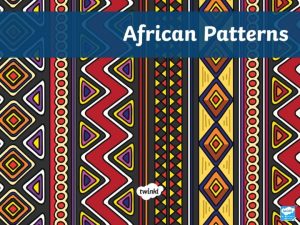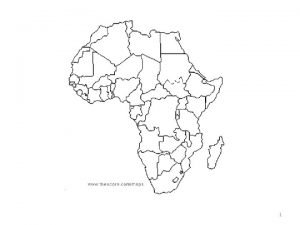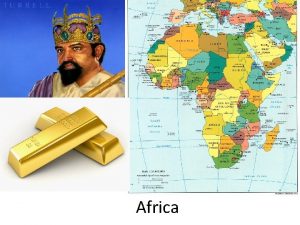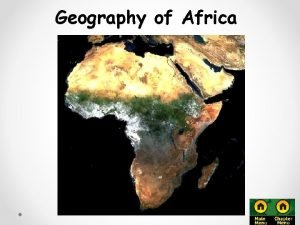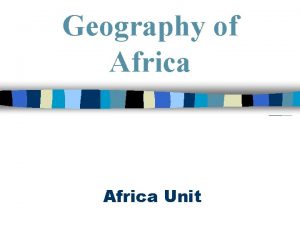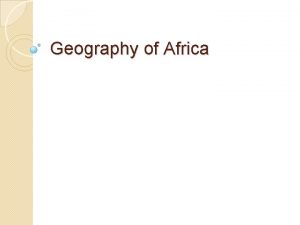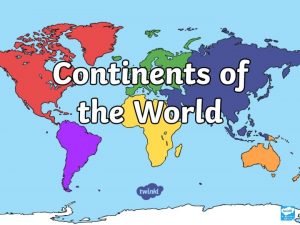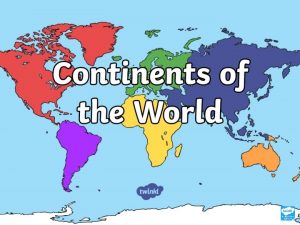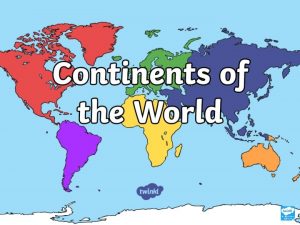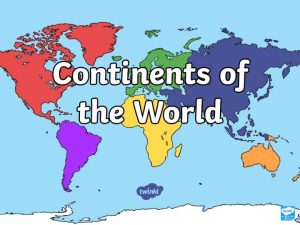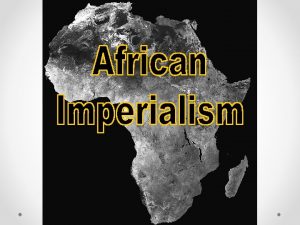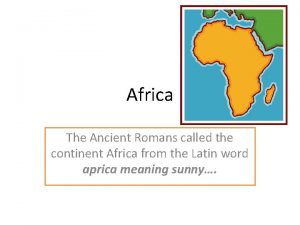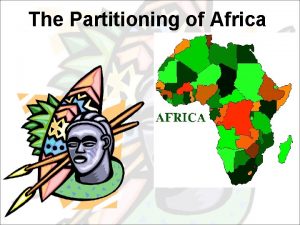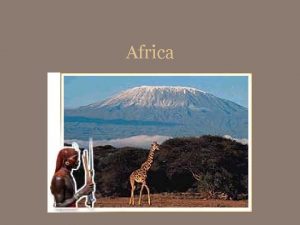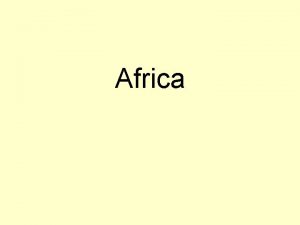Africa 1 Geography Geography The Continent of Africa
















- Slides: 16

Africa 1

Geography • Geography: The Continent of Africa – After Asia, Africa is the second largest continent, covering 1/5 of the Earth’s land surface – Geography is varied, certain features had a major impact on its development 2

• Climate Zones – Tropical rainforests cover less than 5% of the land (mostly on the equator) • Trees and roots make it unstable for farming – Savanna: Grassy plains, that stretch north and south of the forest zone • • Largest and most populated climate zone Generally has good soil and enough rainfall to support farming Irregular patterns of rainfall cause long deadly droughts Cattle herding is a common occupation 3

• The Sahara Desert: In the northern part of Africa, it is the world’s largest desert – Size and harsh terrain limited movement – The Kalahari & the Namib are in the south • Smaller but equally forbidding • Mediterranean Coast of the North and South – Fertile farmland 4

• Movement – Africa is surrounded by Oceans and Seas – Rivers → Zambezi, Congo, Niger, and Nile all serve as open highways – Despite some geographic barriers, people were able to migrate, both within Africa & to neighboring continents • Red Sea & Indian Ocean linked Africa to the Middle East • North Africa allowed for travel to Europe 5

• Resources – Wealth of minerals has spurred trade in many regions • Salt, Iron, Gold & Copper – In the 1800’s, desire for Gold and Diamonds was once cause that led Europeans to seek control of territories in Africa • More recently, nations such as Nigeria and Angola have exported large quantities of oil 6

• Camel Revolutionizes Trade – By 200 AD, Camels had been brought to North Africa from Asia – Traders had earlier made attempts across the desert in horse drawn carriages • Camel caravans created new trade networks • Spread of Islam – In the 600 s Arab armies carried Islam into North Africa • Islam replaced Christianity, which was the dominant religion of North Africa • Arabic replaced Latin as the language • North African traders carried Islam to West Africa 7

Kingdoms of West Africa • The West African Landscape – When the Sahara dried out, people migrated southward into Western Savanna • Farmers grew beans, melons, & a variety of cereal grains • By 100, settled farming villages were expanding along the Senegal & Niger rivers around Lake Chad – In time some villages grew into towns 8

• Trading Patterns – Villages traded any surplus food they produced – Gradually, a trade network linked the Savannah to forest lands in the south • Then funneled goods across the Sahara to the Mediterranean and the Middle East – From West Africa caravans crossed the Sahara, carrying leather goods, Kola nuts, cotton cloth and slaves – Gold For Salt: Gold and Salt dominated the Sahara trade • Gold was plentiful in present day Ghana, Nigeria, and Senegal • Salt, from West Africa, is an abundance in the Sahara – Needed to prevent dehydration, preserve food – Built homes from Salt Blocks 9

Trading Kingdoms of West Africa • Ghana – King was semi-divine figure • Dispensed justice, kept order, had a huge army of foot soldiers with Calvary – Women in Ghana had a high status & played an active role in the economic life of the empire • Some held positions in the government 10

– Influence of Islam • Muslim merchants formed their own communities • Islam spread slowly at first • The King employed Muslims as counselors and officials • Muslims introduced their: – – written language Coinage business methods styles of architecture • City dwellers adopted Islam 11

• Mali – Greatest Emperor was Mansa Musa • Came to the throne in 1312 – Expanded Mali’s borders westward to the Atlantic Ocean – For 25 years he worked to restore peace and order in his empire – Converted to Islam and based his system of justice on the Quran • Didn’t adopt all customs, women were not secluded to the home 12

– The Emperor’s Hajj • Journeyed across the Sahara • Musa was accompanied by 500 slaves, each bringing a Gold staff – Had 100 camels decorated with gold • Finally got to Arabia, reaching Mecca and visited the Kaaba and prayed – Made long journey back across the Sahara to Mali – The Hajj had taken over a year 13

– Results of the Hajj • Mansa Musa showed his devotion to Islam • Made new trading and diplomatic ties with Muslim states, such as, Egypt and Morocco • Returned home with scholars and artists – Newcomers introduced Arab styles in the palaces and Mosques of Mali • Word of Mali’s enormous wealth spread across the Muslim World – European rulers developed an interest in African Gold » Recently began using Gold coins 14

• Songhai – In the 1400’s, civil wars weakened Mali – By 1450 a new West African Kingdom, Songhai had emerged – Sonni Ali used his powerful army to forge the largest state that had ever existed in West Africa • Did not adhere to practices of Islam • Followed traditional beliefs – Askia Muhammad became Emperor after Sonni’s death • Set up a Muslim dynasty 15

– Further expanded the territory of Songhai and improved government – Set up a bureaucracy with separate departments for farming, army, & the treasury • The King appointed officials to supervise each department – Also made a pilgrimage to Mecca – Prospered until 1586, due to civil war • Ruler of Morocco sent his armies south to seize the West African Gold mines • Moroccans'’ were unable to rule an empire across the Sahara 16
 Convergent continental boundary
Convergent continental boundary Convergent boundary
Convergent boundary Is africa the second largest continent
Is africa the second largest continent The plateau continent
The plateau continent Diễn thế sinh thái là
Diễn thế sinh thái là Thế nào là hệ số cao nhất
Thế nào là hệ số cao nhất Lp html
Lp html Vẽ hình chiếu vuông góc của vật thể sau
Vẽ hình chiếu vuông góc của vật thể sau Phép trừ bù
Phép trừ bù Lời thề hippocrates
Lời thề hippocrates Vẽ hình chiếu đứng bằng cạnh của vật thể
Vẽ hình chiếu đứng bằng cạnh của vật thể Thang điểm glasgow
Thang điểm glasgow đại từ thay thế
đại từ thay thế Quá trình desamine hóa có thể tạo ra
Quá trình desamine hóa có thể tạo ra Khi nào hổ con có thể sống độc lập
Khi nào hổ con có thể sống độc lập Thế nào là mạng điện lắp đặt kiểu nổi
Thế nào là mạng điện lắp đặt kiểu nổi Các châu lục và đại dương trên thế giới
Các châu lục và đại dương trên thế giới


